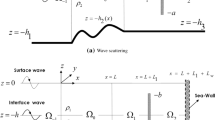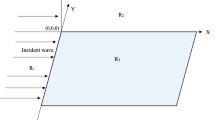Abstract
In the present study, under the assumption of small amplitude water wave theory and structural response, effect of bed undulation on the wave interaction with a combination of flexible porous barrier and a flexible floating plate, is studied. The flexible porous barrier is modelled using the porous wave maker-theory while the elastic floating plate is modelled using thin plate theory. The physical problem is handled for solution using eigenfunction expansion method by matching pressure and velocity at interface boundaries while finite difference method is used to deal with modified mild-slope equation. In the present study, two types of plate configurations are namely (a) finite plate and (b) semi-infinite plate. To understand the role of undulating seabed, wave and structural parameters, in attenuating wave force and plate deflection, numerical results are computed and compared with available literature. It is found that full wave reflection occurs for certain critical angle and wave force acting on the barrier vanishes for the same critical angle for the semi-infinite plate case while the wave reflection tends to attain maximum value at critical angle for the finite case and these maximum value increases with the increase of plate length. It is observed that less wave reflection occurs for sloping bed profile compare to rest of the bed profile. The study reveals that positioning a barrier between plate and undulated region, helps in the reduction of plate deflection significantly. As special case, wave interaction problem with a finite floating elastic plate is studied experimentally and the experimental result has shown good agreement with the numerical result. The findings of the present study are likely to be of immense help in the design of various types of marine structures for protecting very large floating structures (VLFS). The present theory can be extended to handle large class of acoustic wave interaction problems with flexible porous structures.
















Similar content being viewed by others
References
Squire VA (2008) Synergies between VLFS hydroelasticity and sea ice research. Int J Offshore Polar Eng 18:1–13
Lawrie JB, Abrahams ID (1999) An orthogonality relation for a class of problems with high order boundary conditions; applications in sound-structure interaction. Q J Mech Appl Math 52(2):161–181
Sahoo T, Yip TL, Chwang AT (2001) Scattering of surface waves by a semi-infinite floating elastic plate. Phys Fluids 13(11):3215–3222
Manam S, Bhattacharjee J, Sahoo T (2006) Expansion formulae in wave structure interaction problems. Proc R Soc A: Math Phys Eng Sci 462(2065):263–287
Mondal R, Mohanty SK, Sahoo T (2011) Expansion formulae for wave structure interaction problems in three dimensions. IMA J Appl Math 78(2):181–205
Mohapatra SC, Sahoo T, Soares CG (2018) Interaction between surface gravity wave and submerged horizontal flexible structures. J Hydrodyn 30(3):481–498
Hermans AJ (2000) A boundary element method for the interaction of free-surface waves with a very large floating flexible platform. J Fluids Struct 14:943–956
Andrianov AI, Hermans AJ (2005) Hydroelasticity of a circular plate on water of finite or infinite depth. J Fluids Struct 20(5):719–733
Andrianov AI, Hermans AJ (2006) Hydroelastic analysis of a floating plate of finite draft. Appl Ocean Res 28(5):313–325
Tkacheva LA (2004) The diffraction of surface waves by a floating elastic plate at oblique incidence. J Appl Math Mech 68(3):425–436
Watanabe E, Wang CM, Utsunomiya T, Moan T (2004) Very large floating structures: applications, analysis and design. CORE Rept 2:104–109
Kohout AL, Meylan MH, Sakai S, Hanai K, Leman P, Brossard D (2007) Linear water wave propagation through multiple floating elastic plates of variable properties. J Fluids Struct 23:649–663
Mohapatra SC, Ghoshal R, Sahoo T (2013) Effect of compression on wave diffraction by a floating elastic plate. J Fluids Struct 36:124–135
Wang, CM, Tay ZY (2011) Very large floating structures: applications, research and development. In: The twelfth East Asia-pacific conference on structural engineering and construction, pp. 1877–7058
Ohmatsu S (1999) Numerical calculation method of hydroelastic response of a pontoon-type VLFS close to a breakwater. In: Ertekin RC, Kim JW (eds) Proc 3rd Int Wksp VLFS, University of Hawaii at Manao, Honolulu, Hawaii, USA., 1999, 2, pp. 805–811
Maeda H, Washio Y, Osawa H, Sato C, Ikoma T, Onishi Y, Arita M (2000) Characteristics of hydroelastic responses for elastic floating structure with wave energy absorption system in waves. JASNAOE 15:173–178
Utsunomiya T, Watanabe E, Nakamua N (2001) Analysis of drift force on VLFS by the near-field approach. In: ISOPE, pp. 217–221
Hong DC, Hong SY, Hong SW (2006) Reduction of hydroelastic responses of a very-long floating structure by a floating oscillating-water-column breakwater system. Ocean Eng 33(5–6):610–634
Wang K-H, Ren X (1993) Water waves on flexible and porous breakwaters. J. Eng. Mech. 119(5):1025–1047
Chwang AT (1983) A porous-wavemaker theory. J Fluid Mech 132:395–406
Yip T, Sahoo T, Chwang AT (2002) Trapping of surface waves by porous and flexible structures. Wave Motion 35(1):41–54
Lee M, Chwang A (2000) Scattering and radiation of water waves by permeable barriers. Phys Fluids 12(1):54–65
Bhattacharjee J, Guedes Soares C (2011) Oblique wave interaction with a floating structure near a wall with stepped bottom. Ocean Eng 38(13):1528–1544
Lo EYM (1998) Flexible dual membrane wave barrier. J Waterw Port, Coast Ocean Eng 124(5):264–271
Karmakar D, Bhattacharjee J, Guedes Soares C (2013) Scattering of gravity waves by multiple surface-piercing floating membrane. Appl Ocean Res 39:40–52
Karmakar D, Guedes Soares C (2014) Wave transformation due to multiple bottom-standing porous barriers. Ocean Eng 80:50–63
Xiao L, Kou Y, Tao L, Yang L (2016) Comparative study of hydrodynamic performances of breakwaters with double-layered perforated walls attached to ringshaped very large floating structures. Ocean Eng 111:279–291
Geng BL, Wang RQ, Ning DZ (2018) The wave absorption efficiency of multi-layer vertical perforated thin plates. J Hydrodyn 30(5):898–907
Massel SR (1993) Extended refraction–diffraction equation for surface waves. Coast Eng. 19:97–126
Porter D, Staziker DJ (1995) Extensions of the mild-slope equation. J Fluid Mech 300:367–382
Chamberlain PG, Porter D (1995) The modified mild-slope equation. J Fluid Mech 291:393–407
Bennetts LG, Biggs NRT, Porter D (2009) The interaction of flexural-gravity waves with periodic geometries. Wave Motion 46(1):57–73
Manam SR, Kaligatla RB (2012) A mild-slope model for membrane-coupled gravity waves. J Fluids Struct 30:173–187
Athanassoulis GA, Belibassakis KA (1999) A consistent coupled-mode theory for the propagation of small-amplitude water waves over variable bathymetry regions. J Fluid Mech 389:275–301
Belibassakis KA, Athanassoulis GA (2005) A coupled-mode model for the hydroelastic analysis of large floating bodies over variable bathymetry regions. J Fluid Mech 531:221–249
Gerostathis Th, Belibassakis KA, Athanassoulis GA (2016) 3D hydroelastic analysis of very large floating bodies over variable bathymetry regions. J Ocean Eng Marine Energy 2:159–175
Zhu S (2001) Water waves within a porous medium on an undulating bed. Coast Eng 42(1):87–101
Behera H, Kaligatla RB, Sahoo T (2015) Wave trapping by porous barrier in the presence of step type bottom. Wave Motion 57:219–230
Kaligatla RB, Tabssum S, Sahoo T (2018) Effect of bottom topography on wave scattering by multiple porous barriers. Meccanica 53(4–5):887–903
Behera H, Ng CO (2018) Interaction between oblique waves and multiple bottom-standing flexible porous barriers near a rigid wall. Meccanica 53(4–5):871–885
Koley S, Kaligatla RB, Sahoo T (2015) Oblique wave scattering by a vertical flexible porous plate. Stud Appl Math 135(1):1–34
Mandal S, Behera H, Sahoo T (2016) Oblique wave interaction with porous, flexible barriers in a two-layer fluid. J Eng Math 100(1):1–31
Yu X, Chwang AT (1994) Wave-induced oscillation in harbor with porous breakwaters. J Waterw, Port, Coast Ocean Eng 120(2):125–144
Wu C, Watanabe E, Utsunomiya T (1995) An eigenfunction expansion-matching method for analyzing the wave-induced responses of an elastic floating plate. Appl Ocean Res 17(5):301–310
Porter R, Porter D (2000) Water wave scattering by a step of arbitrary profile. J Fluid Mech 411:131–164
Acknowledgement
SM is gratefull to Council of Scientific and Industrial Research (CSIR) for funding this work through MLP 1701. SK B is gratefull to Ministry of Human Resource Development, Government of India for providing Graduate Aptitude Test in Engineering (GATE)(CE16S57010055) fellowship. The authors declare that they have no conflict of interest. This article bears NIO contribution number 6563.
Funding
Council of Scientific and Industrial Research (CSIR) (MLP 1701), Graduate Aptitude Test in Engineering (GATE) Fellowship (CE16S57010055).
Author information
Authors and Affiliations
Corresponding author
Ethics declarations
Conflict of interest
The authors does not have any conflict of interest.
Additional information
Publisher's Note
Springer Nature remains neutral with regard to jurisdictional claims in published maps and institutional affiliations.
Rights and permissions
About this article
Cite this article
Mandal, S., Kumar, B.S. & Shashikala, A.P. Effect of undulating bottom on wave interaction with a floating flexible plate coupled with a flexible porous barrier. Meccanica 55, 1801–1820 (2020). https://doi.org/10.1007/s11012-020-01212-3
Received:
Accepted:
Published:
Issue Date:
DOI: https://doi.org/10.1007/s11012-020-01212-3




